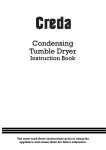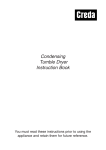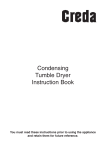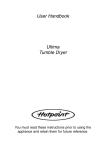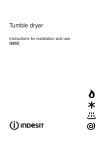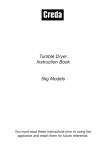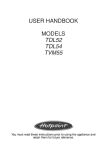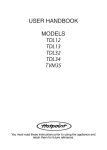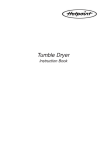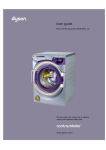Download TUMBLE DRYER - Indesit Company UK
Transcript
TUMBLE DRYER INSTRUCTION BOOK 5Kg MODELS You must read these instructions prior to using the appliance and retain them for future reference. Contents Page Safety advice 3-4 Electrical requirements 5 Features - get to know the main parts of your dryer 6 Where to put and vent your dryer 7-8 How to use your dryer 9 Sorting your laundry 10 Wash Care labels 11 Items not suitable for tumble drying 11-12 Items requiring special attention The Controls - options 12 13-15 Guide to drying times 16 How to remove and clean the fluff filter 17 Caring for your dryer 18 If something goes wrong 20 Retention of this Instruction Book This Instruction Book must be kept handy for reference as it contains important details on the safe and proper use of the appliance. If you sell or pass the appliance to someone else, or move house and leave it behind, make sure this Book is also provided so the new owner can become familiar with the appliance and safety warnings. 2 For your safety IMPORTANT Using your Tumble Dryer is easy. Nevertheless, for your own safety and to get the best results it is important to know your Dryer by reading right through this handbook before using your dryer for the first time. NEVER NEVER NEVER NEVER NEVER NEVER NEVER NEVER NEVER NEVER NEVER NEVER NEVER NEVER NEVER NEVER NEVER ● Allow children to play with or otherwise interfere with the dryer. ● Allow the air inlet at the back of the dryer, the air outlet or vent hose to be obstructed. ● Direct the vent hose outlet towards the air intake at the back of the machine. ● Allow the tumble dryer to recycle exhaust air. ● Switch the machine off leaving a hot load in the drum. ● Tumble dry without the filter in position. ● Exceed the maximum load capacity recommended or place dripping wet items in the drum. ● Use the dryer on a carpeted floor where the pile height would prevent air from entering the dryer from the base. ● Allow lint to collect around the dryer. ● Add liquid or sheet fabric conditioner to the dryer, use liquid conditioner in the final rinse of your wash. ● Use the dryer for commercial drying, the dryer is only suitable for domestic use. ● Dry Acrylics on the high heat setting. ● Tumble articles that have NOT been well washed in water and detergent then well rinsed and spun. ● Dry articles that are contaminated with flammable substances such as: petrol, oil, paint, hair lacquer, creams, cooking fat or oil. ● Tumble dry: rubber, foam rubber, plastic, plastic foam, nappy pants or liners, polythene or paper. Any dry cleaned garments. ● Never attempt to stand on top of your dryer, it is not designed for such use and you could injure yourself or damage the dryer by such abuse. ● Switch electricity On or Off with wet hands. IMPORTANT A CHILD COULD CLIMB INTO OR TAMPER WITH AN UNATTENDED TUMBLE DRYER. WHEN THE MACHINE IS NOT IN USE SWITCH OFF, REMOVE THE PLUG AND CLOSE THE DOOR. 3 For your safety ALWAYS ● When the dryer is not in use, switch off at the wall, remove plug and close the door. ALWAYS ● Comply with the specified electrical requirements. ALWAYS ● Ensure that your dryer is installed correctly and has adequate ventilation. (see, "Where to put and vent your dryer." ALWAYS ● Use the vent hose for optimum drying performance. ALWAYS ● Finish every programme with the cool tumble cycle provided on the control. ALWAYS ● Clean the filter, it is essential that the filter is kept clear of fluff after EACH drying cycle. ALWAYS ● Observe the rules for drying garments: In particular woollen articles should not be dried in a tumble dryer unless they are labelled ‘Superwash’, ‘Machine washable’ or have the ‘May be tumble dried’ symbol: If in any doubt do not dry wool in the machine. Unlike other materials, the mechanism of wool shrinkage is irreversible, i.e. it will not stretch back to the original size and shape. ALWAYS ● Buy genuine accessories and spares. 4 Electrical Requirements WARNING: This appliance must be earthed! Supply REFER TO THE RATING PLATE FOR VOLTAGE AND CURRENT REQUIREMENTS. (see diagram for location.) The flexible mains lead is supplied fitted with a BS1363 plug and with a 13 amp BS1362 fuse. The plug should be connected to the mains supply via a suitable switched socket which is accessible after installing your dryer. Changing the fuse If it is necessary to fit a replacement fuse, it must be a 13 amp ASTA approved to BS1362 type. Moulded plug WARNING: The plug must not be used without a fuse cover. If a replacement fuse holder/cover is required, it must be of the same colour coding or wording as shown on the base of the plug. Replacements are available from your Spares stockist. Changing the plug The wires in the mains lead are coloured in accordance with the following: GREEN/YELLOW - EARTH BLUE - NEUTRAL BROWN - LIVE Rewirable plug If a replacement plug is to be fitted, the appropriate wire must be connected to the correct terminal, the following gives some examples. Connect: Green/Yellow to terminal marked Earth or Green or Blue to terminal marked Neutral or N or Black Brown to terminal marked Live or L or Red. if the plug being replaced is a non-rewirable type then the cut-off plug must be disposed of safely. DO NOT leave where it can be inserted into a socket and create a shock hazard. GREEN & YELLOW TO EARTH 13 AMP FUSE BLUE TO NEUTRAL CORD CLAMP BROWN TO LIVE Changing the mains cable Should the mains lead ever require replacing at any time please contact your nearest Service Centre. A charge will be made for the replacement of the mains lead or if you require a longer lead. The mains lead must only be replaced by a specially prepared cable obtainable from your Spares Stockist and fitted by a qualified electrician. NOTE: IF IN DOUBT ABOUT ANY OF THE ABOVE CONSULT A QUALIFIED ELECTRICIAN. 5 Features - Get to know the main parts of your dryer See “The Controls” NOTE: if your dryer is new wipe out the inside of the drum before you first use it to remove any dust which may have accumulated during transit. Drum Model and serial numbers FLUFF FILTER Clean after each use Fig. 2 Front vent with hose (Vent cover at rear) Fig. 1 Rating plate Air intake grille Vent Cover Fig. 4 Caution Hot Fig 3. Vent hose fitted here Wall/window vent (Vent cover at front) 6 Rear venting with hose (Vent cover at front) Where to put and vent your dryer ● Your tumble dryer should NOT be located adjacent to a gas hob, cooker, heater, or eye level grill as flames from the burners could cause damage to your machine. ● When the dryer is fitted under a work surface, allow space for air to enter the rear grille, 10mm above the dryer minimum. ● If you are using this dryer adjacent or stacked on top of a washing machine SEPARATE mains plugs and sockets must be used for each appliance. DO NOT use 2-way adaptors or extension leads. Both your tumble dryer and front loading washing machine are Stack it on your similar in design allowing the tumble dryer to be permanently washing machine stacked on top saving you valuable floor space. A special stacking kit complete with instructions is available from your retailer or nearest Spares Centre. IMPORTANT: Only use genuine stacking kits. When ordering you must state the model numbers of both your Washing Machine and your Tumble Dryer. Unsuitable kits may result in a potential hazard and will invalidate your warranty rights. Venting options ● ● ● ● ● ● ● Some models are designed to give the option of venting the moist air from the front of the dryer. The dryer as supplied is rear venting. Some models can be converted to front venting by removing the vent cover from the aperture on the front (Fig. 1) of the dryer and fitting it in the aperture at the back. A vent hose is recommended for optimum performance. A vent hose must be used if the rear venting option is used. (If this is not supplied it can be obtained from your retailer or Spares Centre). When front venting without a hose a window must always be opened to reduce condensation. The hose must be fitted securely into the dryer, as shown on the diagrams on the previous page. If possible it is always best to connect the hose to a permanent outlet close to the dryer (see instructions on next page). Ensure that the end of the hose is not directed towards the air intake grille at the rear of the dryer. If permanent installation is not possible, the dryer will work just as well with the hose passed through a partly opened window. (See diagram on next page). NOTE: The vent hose should not exceed 2.4 metres in length, and should be kept free of any possible accumulation of fluff lint (and water) by frequently shaking it out. Always ensure that the hose is not squashed. 7 Where to put and vent your dryer Permanent Venting In conjunction with the vent hose we recommend the use of a Wall/Window Vent Kit. These are available from your retailer or nearest Spares Centre. Wall/Window Venting Fitting instructions are supplied with the kits, which can be mounted through a wall or window. Details of positioning for wall mounting are as follows:- Break a hole through the wall to the left of the proposed position for the dryer. Keep the hose as short and straight as possible to prevent condensed moisture running back into the dryer. Similarly the duct inserted into the wall should slope downwards to the outside. For window venting with stacked dryer, the hole in the window should ideally be made below the outlet and the hose should be kept as short as possible. A B Depending on the frequency of use, it is essential that the areas A and B in the illustrations are checked periodically and any fluff or debris removed. It is particularly important that the vent hose adaptor is fitted securely thus preventing any moisture laden air from being emitted back into the room. NOTE: The dryer should not be pushed so far back that the hose adaptor is pulled out of position or the hose squashed. The hose should be kept clear of the air intake grille and kinks or ‘U’ bends avoided as these will obstruct the hose or trap condensation. Storm cover WARNING: B B 1. ENSURE THAT THE DRYER IS ADEQUATELY VENTILATED AND THAT THE END OF THE VENT HOSE IS NOT DIRECTED TOWARDS THE AIR INTAKE DUCT. 2. THE DRYER MUST NOT RECYCLE EXHAUST AIR. 3. THE VENT HOSE MUST ALWAYS BE FITTED FOR OPTIMUM PERFORMANCE. 4. MAKE SURE THAT THE VENT HOSE AND AIR INTAKE GRILLES ARE NOT OBSTRUCTED OR BLOCKED. 5. MISUSE OF A TUMBLE DRYER MAY CREATE A FIRE HAZARD. For open window venting it must be possible for the end of the hose to be directed downwards to prevent warm, moist air condensing in the room or in the dryer. 8 How to use your dryer 1. Plug in, switch on electricity. 2. Sort your laundry (see section “Sorting Your Laundry”) WARNING: WHEN SWITCHING ON OR OFF, PLEASE ENSURE THAT YOUR HANDS ARE DRY 3. Open the door. Check that the fluff filter is clean (see section How to remove and clean the fluff filter). 4. Load the dryer placing the clothes carefully in the drum pushing them well towards the back and away from the door seal. Close the door. 5. Lock the door handle (where lock is fitted). The edge of a suitable coin can be used to rotate the lock. 6. Select the relevant heat setting (see section “The Controls”). LOCKED 7. Select the required programme/ drying time. (see section “The Controls”). The dryer will start. Button IN or Rocker DOWN HIGH HEAT Button OUT or Rocker UP LOW HEAT 8. When finished, unlock and open the door and take out the laundry. Clean and replace the fluff filter. UNLOCKED 9. Switch off electricity and remove plug from socket. Lock the door to prevent access (Where lock is fitted). Cool Tumble Phase WARNING: WHEN SWITCHING ON OR OFF, PLEASE ENSURE THAT YOUR HANDS ARE DRY. LOCKED About 10 minutes before the programme is completed, the heating elements will be switched off, and the programme enters the final ‘Cool Tumble’ phase. During this phase the fabric is cooled. You should always allow the dryer to complete this phase. By opening the door you can check the dryness of the load as often as you wish, and if you want to remove some items before they are fully dry. (This is particularly useful for a mixed load where you want to iron some items but others are to be fully dried). Never switch the dryer off with a hot load in the drum. You must terminate every programme with the Cool Tumble Phase. 9 Sorting your laundry 1. Always separate laundry into the correct fabric groups before washing and drying. 2. See that all zips are closed, hooks and eyes are fastened and belt, strings etc. are tied loosely in bows, you will normally have done this for each item before the washing stage. 3. It is important to extract as much water as possible from each item before drying. This saves you time and money. WARNING: CLOTHES SHOULD NEVER BE LOADED DRIPPING WET 4. Make sure that the items to be dried are suitable for tumble drying, or are not of a type requiring ‘special attention’ (see“Wash Care Labels” section). Maximum load size Your dryer will hold a load of 5kg (11lb) dry weight of natural fabrics. if you are drying items of man-made fibres (synthetic or acrylics), the maximum load should not exceed 3kg (6.6lb) dry weight. This difference is that man-made fibres require more space to tumble-dry without creasing. WARNING: DO NOT OVERLOAD AS THIS COULD RESULT IN REDUCED DRYING PERFORMANCE AND A POSSIBLE FIRE HAZARD. Typical load To help you estimate how many items it takes to make up a drying load, the charts below show the approximate weights of some everyday washing items. Clothes Blouse Dress Jeans 10 Nappies Shirt Household Items Cotton Other 150g 5oz 100g 31/2oz Duvet cover (Double) Cotton Other 500g 350g 700g 1000g 300g Large Tablecloth 700g 1lb 6oz Small Tablecloth 250g 9oz Tea Towel 100g 31/2oz Bath Towel 700g 1lb 8oz Cotton Other T-Shirt 1lb 2oz 12oz 1lb 6oz 2lb 3oz 101/2oz 200g 7oz 125g 41/2oz Cotton 1500g 3lb 5oz Other 1000g 2lb 3oz Hand Towel 350g 12oz Double Sheet 500g 1lb 2oz Single Sheet 350g 12oz If you group small cotton or terry-towelling items with a synthetic fabric load they could be damp at the end of the drying cycle. If this happens simply give them an additional short period of drying to finish them off. 10 Wash Care Labels Most of today’s fabrics can be tumble dried in your Dryer with no trouble at all, but there are certain fabric finishes which should be dried away from direct heat. The majority of garments now have wash-care labels on them, giving full washing and drying instructions. These should always be followed carefully especially when you are drying something for the first time. Typical symbols are: May be tumble dried Do not tumble dry Or: Tumble dry at high heat setting Tumble dry at low heat setting Items not suitable for tumble drying • Those containing foam rubber or rubber-like materials or plastic film (e.g. pillows, cushions, PVC rainwear), or any other articles which are inflammable or contain inflammable substances (e.g. towels contaminated with hair lacquer • Fibreglass (e.g. some types of curtains) • Items which have been dry cleaned • Woollens. Woollen items need as much care in drying as they do in washing. The movement of the tumble-drying action causes the woollen fibre to shrink and distort. • Garments with the ITCL Code Do not tumble dry. • Large bulky items e.g. continental quilts, sleeping bags, pillows, cushions, double blankets and large bedspreads. These expand when drying and would prevent airflow through the Dryer. WARNING: THE DRYER IS INTENDED FOR USE ONLY WHERE WATER SOLUTION IS USED FOR THE CLEANING PROCESS. MISUSE OF A TUMBLE DRYER MAY CREATE A FIRE HAZARD. 11 Items requiring special attention Blankets and Bedspreads The drying requirements of blankets and bedspreads will, of course, vary tremendously according to size and weight. Some, however are simply too big. if you have difficulty getting them into the Dryer, the machine will have difficulty drying them properly. Blankets (and Garments) made from Acrylic fibres (e.g. Acilan, Courtelle, Orion and Dralon) must be dried with special care on Low heat setting. Overdrying should be avoided to ensure heat creasing does not occur. Woollen blankets can however be dried on the Full heat setting if required. Your dryer will cope with such clothes very well, but you should Permanently pleated or creased always read the manufacturer’s drying instructions attached to the garment before you begin. garments Starched articles Starched articles should be dried together in the same load to avoid the distribution of starch to non-starched items. You should use a slightly heavier starch solution than you would when drying the items on the washing line. Make sure that as much of the solution is removed from the load as possible before placing it in the Dryer. Remove the items from the dryer as soon as they reach ironing dampness. If they are overdried the starch will powder, leaving the fabric limp - which rather defeats the purpose of the exercise! Fabric conditioner To make sure all your tumble dried clothes come out really fresh and soft we recommend you use a liquid fabric conditioner in the final rinse of your wash. A liquid fabric conditioner restores bounce and softness and helps eliminate static cling. WARNING: ON NO ACCOUNT SHOULD LIQUID OR SHEET FABRIC CONDITIONER BE ADDED TO THE DRYER ITSELF. 12 The Controls Your dryer will have either of the following Console panel layouts. Not all the features are found on all models, the following pages explain the options on your particular model. When fitted with Rocker switch Console panel Heat select switch Eco sense light Filter care light When fitted with ‘Push-Push’ switch Console panel Filter care light Eco sense light Heat select switch Heat Select Two types of selection switch can be fitted as shown above. Select Full (High) or Gentle (Low) dependent on the fabric you are drying. (See section “Sorting your Laundry”). Full heat is selected with the ‘rocker’ switch down, when a green marker is visible, or when the ‘Push-push’ type is in the ‘IN’ position. To select low heat on the ‘Push-push’ type, push the switch again (OUT position). Door Release To open door, grip the release handle and pull. If the door is opened while the dryer is in use, the drying programme cuts out automatically and the dryer stops. When the door is closed the dryer will restart but you will not need to reset the timer unless you wish to change the setting. 13 Options Filter care light (Selected models only) Whenever the door is opened and there is power supplied to the dryer, the light marked ‘Filter care’ will glow. This light advises the user to check the filter is clear of fluff. It does not necessarily mean that the filter is blocked or that there is anything wrong with the dryer. The light will go out when the door is closed. Options - Auto/Autodry Models These models have a heat switch and on selected models a Filter care light. Timer Control Turn the Timer clockwise to select the required drying time. The drying time for both heat settings is controlled by the timer. All you have to do is turn the Timer control clockwise until the required time appears in line with the indicator. Do not rotate the knob beyond 120 minutes (maximum drying time) or past the zero stop. If you have selected more time than you require turn the knob anti-clockwise to select the correct time required. This operation also starts the dryer, provided the door is closed and the machine is plugged in. The”Guide to Drying Times” section will tell you how much time you will need for various loads. Options - Reversair/Reverse Action Models These models have a heat switch and on selected models a Filter care light. Timer Control 14 Turn the timer clockwise to select the required drying time. The drying time for both heat settings is controlled by the timer. All you have to do is turn the Timer Control clockwise until the required drying time appears in line with the indicator. Never wind the timer control anti-clockwise. This operation also starts the dryer, provided the door is closed and the machine is plugged in. The “Guide to Drying Times” section will tell you how much time you’ll need for various loads. Options - Sensair/Reversair Automatic ECO models These models have a heat selection switch, an automatic/Eco light. (Not fitted to all models.) Programme Options To set the required programme all you have to do is turn the Timer Control clockwise until the required selection appears in line with the indicator. Never turn the timer control anti-clockwise. This operation also starts the dryer, provided the door is closed and the machine is plugged in. 1. Automatic Drying average loads. e 2. Automatic drying large loads. E 3. Timed Drying 4. Cool Tumble phase. (i) Automatic drying The Eco drying programmes will automatically dry most loads to the fully dry ready to wear condition. This eliminates the need to guess the drying times and saves energy. High heat MUST be selected (Heat Switch IN or Down). To select ECO drying turn the selector to position e for average loads and E for large loads. e ‘ECO’ drying average loads 1 to 3Kg Cottons, Polycottons or Synthetics (Dry weight) E ECO drying large loads 3 to 5Kg Cottons (Dry weight) When the door is closed the Eco Drying light will glow to indicate that ECO drying programme is running. When the load is dry, the selector will automatically advance to the 8 minute cool tumble phase. Note: • If LOW heat is selected for an ECO drying programme, the dryer will advance to COOL without drying the load. • For acrylics and acrylic mixtures, select LOW heat and use timed drying. • Small loads (Less than 1Kg) must be dried using the timed drying programme. ECO sense light (some models) (iii) Timed drying This light will glow when ECO drying is selected. It will stop glowing when the load is dry and the programme advances to the Cool Tumble phase. To set the required time, all you have to do is turn the Timer Control Clockwise until the required time appears in line with the indicator. Never turn the timer control anti-clockwise. The chart in the section “Guide To Drying Times” will tell you how much time you’ll need for various loads. This programme is particularly useful in cases where a damp load is required for ironing or LOW heat drying is required and also for small loads. About ten minutes before the programme is completed, the heating elements are switched off and the programme enters the final ‘Cool Tumble’ phase. 15 Guide to Drying Times Please note that the Drying Times stated below and on appliance control panel are a GUIDE only and drying times are affected by: Items such as towelling retain a lot of water after spinning, also the The amount of water remaining in suggested wash programme for small items such as T-Shirts may sometimes incorporate a low spin speed which has the same effect. the clothes after spinning The type of fabric Your drying load may contain the same type of fabric but of different thicknesses. Thinner items will take less time to dry. Some fabrics, such as those used for jeans are of closer texture than others and although light when dry will be heavy after washing and spinning. Single items of clothes or small loads may take disproportionally The quantity of clothes to be dried longer to dry. It is more energy efficient to dry larger loads. How dry you want As it takes longer to fully dry clothes than to have them ready for ironing, you may wish to remove some clothes when they are slightly the clothes damp, ready for ironing and then continue to dry the remainder until they are fully dry. The label on the garment should tell you the correct heat setting to The heat setting you have selected select. See ‘Wash Care Labels’. The temperature of the room If the room in which the dryer is situated is cold, your clothes will take longer to dry than if the room is warm. Bulky items Some bulky items such as padded jackets can be dried, with care, and we do advise that you remove these items several times, shake them and return them to the dryer. THERE ARE HOWEVER SOME ITEMS THAT WE DO NOT ADVISE YOU TO DRY. SEE ‘ITEMS NOT SUITABLE FOR TUMBLE DRYING’ Drying Guide - approximate drying time in minutes (weights specified are when dry) COTTONS SYNTHETICS High Heat Drying times 800 - 1000rpm in washing machine 1 kg 20 - 30 2 kg 35 - 45 Be careful not to overdry 16 ACRYLICS High Heat Half load 3 kg 45 - 60 4 kg 60 - 70 Gentle Heat Drying times on reduced spin in washing machine Full load 5 kg 70 - 80 1 kg 20 - 30 Half load 2 kg 35 - 45 Full load 3 kg 45 - 60 Drying times on reduced spin in washing machine Half load 1 kg 25 - 40 Full load 2 kg 40 - 60 All fabrics contain a little natural moisture even when ‘dry’ and this natural moisture should not be lost if the clothes are to remain soft and fluffy. Clothes that are dried for too long tend to wrinkle and will need more ironing than usual giving you extra work that the dryer was designed to remove. How to remove and clean the fluff filter Position of filter WARNING: NEVER USE SHEET FABRIC CONDITIONER. IT MAY FALL INTO THE FILTER AND RESTRICT THE AIRFLOW THROUGH THE DRYER To remove the filter A very important part of your dryer is the fluff filter at the front edge of the drum. It’s there to trap the particles of lint and fluff which are normally blown away when clothes are dried on the washing-line. if the filter is allowed to become blocked, the passage of warm air through the drum will be severely restricted. This means your clothes will take much longer than normal to dry and the cost of drying them will be increased. it may also damage your dryer. Small items, e.g. babies socks, may fall onto the filter. These should be removed so that the filter is not restricted. WARNING: DO NOT OPERATE THE DRYER WITHOUT CLEANING THE FILTER AFTER EACH DRYING CYCLE. FAILURE TO CLEAN THE FILTER MAY RESULT IN A FIRE HAZARD. Grip the centre rib and pull the filter upwards and forwards through the door seal (see diagram). Open the filter, and remove the fluff that has collected on the inside. Wash or vacuum clean the filter occasionally. Don’t be alarmed by the amount of fluff you may find on the filter. It’s part of the wearing, washing and drying process. WARNING: DO NOT OPERATE THE DRYER WITHOUT THE FILTER IN POSITION. It is essential that the filter is replaced correctly. It must be fitted so that the symbols, shown on the filter above, face towards the front of the dryer. Ensure the filter is fully located into the tumble dryer duct. 17 Caring for your Dryer Your tumble dryer needs very little attention. The following simple steps will keep it performing well. When finished Switch off electricity and remove plug. After each load Always clean the filter and turn the drum by hand to check that small items like handkerchiefs do not get missed. As necessary Clean exterior metal and plastic surfaces with a damp cloth or silicon polish only. Regularly check and clean if necessary, the vent hose and any permanent venting fixture to ensure that there has been no accumulation of fluff or lint during the drying process. Do not use abrasive cleaners, scouring agents, acids, chlorine bleach or metal polish to clean any part of the machine. These could damage the machine. Clean fluff from the area behind the front venting adaptor fitted at the lower left hand corner of the front panel (not fitted to rear venting only models). The adaptor can be removed by turning it anticlockwise a twelfth of a turn. Refitting is the reverse of the above. Lubrication Your tumble dryer uses special bearing components. Lubrication by the user is not necessary and must not be attempted. We strongly recommend that all appliances are regularly checked for electrical and mechanical safety. 18 If it still won’t work... Spare parts Please remember your new appliance is a complex piece of equipment. ‘DIY” repairs or unqualified and untrained service people may put you in danger, could damage the appliance, and might mean you lose cover under the Parts Guarantee. If you do experience a problem with the appliance don’t take risks, call in our Service Engineer. Our Spare Parts are designed exclusively to fit your appliance. Do not use them for any other purpose as you may create a safety hazard. Disposal of your product To minimise the risk of injury to children please dispose of your product carefully and safely. Remove all doors and lids. Remove the mains cable (where fitted) by cutting off flush with the appliance and always ensure that no plug is left in a condition where it could be connected to the electricity supply. To help the environment, Local Authority instructions should be followed for the disposal of your product. This appliance conforms to the following EEC Directives. Low Voltage Equipment 72/23/EEC 93/68/EEC Electromagnetic Compatability 89/336/EEC 92/31/EEC 93/68/EEC 19 If something goes wrong First, don’t panic! There may be nothing wrong at all. Look for your problem below, then check the things we suggest. More often than not, this will give you the answer to your problem, and you’ll be able to carry on without having to telephone your Service Centre. If after this you still cannot get your machine to work, follow the advice given on the next page. Problem Check these things first ‘It won’t start’ 1. 2. 3. 4. ‘It is taking a long time to dry’ 1. Have you forgotten to clean the filter? Check it. 2. Have you selected the correct Heat setting for the type of fabric you are drying? (IN for High, OUT for low). 3. is the flexible vent hose squashed, blocked or kinked? Check it for foreign objects or condensate (water). 4. Is the air inlet obstructed in any way? 5. Permanent venting - is flap on the storm cover obstructed? 6. Were the clothes ‘excessively wet’ when they were put in? 7. Was the correct programme/time selected? 8. Have you overloaded the dryer? Is the machine plugged in and switched on at the socket? Is the Timer Control set to required programme/time? Is the door securely closed? Has the fuse blown, either in the plug or the main fuse box? (Try plugging in another appliance to check) If the fuse has blown refer to Electrical Requirements section. 5. Have you used an extension lead? Many are not suitable. Try plugging the dryer directly into a socket to check. Auto Programmes 1. Has the correct programme been selected for the load? (Some models) 3 - 5kg programme E 1 - 3kg programme e Less than 1kg use timed dry programme. 2. Has high heat been selected? The Auto programmes will not operate on low heat, if low heat is required use timed dry. ‘The dryer keeps buzzing’ (Some models) This is perfectly normal, the dryer has finished its programme. Press the audio button and the buzzing will stop or turn the timer control to the off ‘O’ position. Any other problem Have you re-read this instruction book? 20 Service Please carry out the checks detailed on the Something Wrong page. If there is a problem with your appliance then contact your Service Centre by using the table below to identify the appropriate phone number. Please have the following information available when you call : 1. (a) Your name. (b) Your address and postcode. (c) Your telephone number. 2. The date and the name of the shop/retailer where the appliance was purchased. Shop / Retailer : Date : 3. The Model number and Serial number of your appliance (See Features page for Rating plate location). Model Number : Serial Number : 4. Clear and concise details of the fault. 5. Details of any Extended Warranty or Service Insurance Schemes. Your In-Guarantee Service Telephone Number UK Republic of Ireland 0541 500 500 1850 302 200 If you have any other queries regarding Service or Parts, our Parts and Service division will be pleased to help. You should write to : Creda Service, Customer Service Department, Blythe Bridge, Stoke-On-Trent. ST11 9LN. For Parts and Accessories, please telephone our Parts Order Hotline on 0541 530 530 (UK) or 01 842 6836 (Republic of Ireland). Note 1 : If under guarantee, our Engineers will need to see a copy of your purchase receipt when they call. Note 2 : Our Engineers will use every effort to avoid damage to floor coverings and adjacent units when carrying out repair/service work, but in locations where the Engineer advises you that it will be impossible to move the appliance without risk of damage, he will only proceed with your approval that no liability will be accepted. PRINTED BY SIMLEX . FOUR ASHES, WOLVERHAMPTON. February 1999 Part No.375000091-01

























